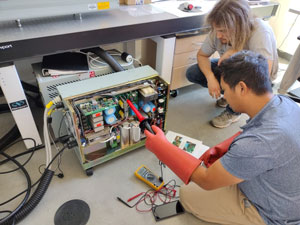Welcome to the GEOS 440, Environmental Sensing, webpage for the Fall 2022 semester.

Jaydie Lee and Hayden Romiti check high voltages on a Nd:YAG laser power and cooling unit for the REAL lidar.
The environmental sciences require critically on electronics, measurements, and data.
This page will be updated every few days as the course progresses...
Required book: Meteorological Measurement and Instrumentation by Giles R. Harrison, (c)2015.
Link to on-line library version (requires csuchico.edu connection).
Link to Publisher.
Aug. 22, Mon., Lecture: Review syllabus, and start with basic vocabulary in instruments.
Aug. 24, Weds., Lecture: Begin Chapter 2. Principles of Measurement and Instrumentation with focus on analog to digital conversion.
Aug. 22 & 23: Lab 1: Blinking an LED light with an
Arduino Due and introduction to Matlab.
Aug. 29, Mon., lecture: Dr. Eric Ayars on voltage dividers for thermistors.
Aug. 31, Weds., Lecture: Continue Chapter 2: Terms characterizing instrument performance (Table 2.2).
Aug. 29 & 30: Lab 2: Wiring a thermistor, looking carefully at resolution, and importing data into Matlab
Sept. 5, Mon. Labor Day, no lecture
Sept. 7, Weds. Lecture: Response time (or time constant) of an instrument. Derivation of Eqn. 2.2 in Harrison.
Sept. 5 & 6: Labor Day, no labs
Sept. 12, Mon. Lecture: Random noise in measurements, mean, standard deviation, standard error, accuracy, precision, etc.
Sept. 14, Weds. Lecture: Begin Chapter 5: Temperature and thermometers. Thermoscopes and liquid-in-glass (LIG) thermometers (mercury and alcohol)
Sept. 12 & 13: Lab 3: Practice soldering and solder
Arduino data shields
Sept. 19, Mon. Quiz #1. Lecture: Reference environments and measurements, calibration, errors in LIG thermometers, bimetallic strip thermometers.
Sept. 21, Weds., Lecture: Electronic thermometers.
Sept. 19 & 20: Lab 4: Set real-time clock and record date/time/temperature data on SD memory card on data shield. (Photo) Plotting data in Matlab.
Sept. 26, Mon. Lecture: Review term project proposals
Sept. 28, Weds., Quiz #2 on Temperature & thermometers. Continue discussion of term project. Finalize parts order list.
Sept. 26 & 27, Lab 5: Thermistor/Due performance characterization experiments: accuracy, precision, response time, and resolution
Oct. 3, Mon. Lecture: Discuss Lab plots. Then, Begin Ch. 9 on Electromagnetic Radiation and Radiometers. Temperature versus radiation.
Oct. 5, Weds., Lecture: Planck's Law as a distribution function. Integration to obtain the Stefan-Boltzmann Law.
Oct. 3 & 4, Lab 6: Complete thermistor/Due performance characterization experiments. Answer questions on
term project.
Oct. 10, Mon. Lecture: Begin methods of detecting radiation: photon counting, thermopiles, photodiodes, and photoresistors. Pyranometers.
Oct. 12, Weds., Lecture: Thin film coatings. Direct and diffuse solar radiation. Begin infrared radiation: pyrgeometers.
Oct. 10 & 11, Lab 7: Begin work on term project.
Oct. 17, Mon. Lecture: Emissivity. Then discussion of the Soffer and Lynch (AJP, 1999) paper and the location of peaks in Planck functions.
Oct. 19, Weds., Quiz #3 on Radiation and Radiometers. Lecture: Begin humidity: absolute & specific humidity, mixing ratio, and relative humidity
Oct. 17 & 18, Lab 8: Work on term project.
Oct. 24, Mon. Lecture: Discussion of term project presentations. Then revisit humidity: absolute humidity as density, and introduce dew point.
Oct. 26, Weds., Lecture: Hygrometers: chilled mirror hygrometers, hair hygrometers, sling psychrometers, and electronic and spectroscopic humidity sensors.
Oct. 24 & 25, Lab 9: Work on term project.
Oct. 31, Mon. Quiz #4 on Humidity. Then Lecture: Begin Chapter on Pressure. Importance of pressure and pressure as function of depth in liquid.
Nov. 2, Weds., Lecture: Derive hydrostatic eqn. and barometric laws and begin barometers: manometers, mercury barometers, and the pressure hypsometer.
Oct. 31 & Nov. 1, Lab 10: Work on term project.
Nov. 7, Mon. Lecture: Complete Ch. 7 on barometers: flexible diaphragms, aneroids, electronic barometers, static and dynamic pressure.
Nov. 9, Weds., Lecture: Quiz #5 on Pressure and Barometers. Begin Ch. 8 on Wind Sensors: the importance and nature of wind near the surface.
Nov. 7 & 8, Lab 11: Work on term project.
Nov. 14, Mon. Lecture: Nature of wind near the surface. Coherent structures, static stability/instability, log-wind profile. Begin types of wind sensors.
Nov. 16, Weds., Lecture: Complete various types of wind sensors: pitot tubes, cup, propellor, and sonic anemometers, wind vanes.
Nov. 14 & 15, Lab 12: Work on term project.
Nov. 21, Mon.: Thanksgiving Week: no lectures or labs
Nov. 23, Weds.: Thanksgiving Week: no lectures or labs
Nov. 21 & 22: Thanksgiving Week: no lectures or labs
Nov. 28, Mon.: Lecture: Pibals, radiosondes, dropsondes, then active remote sensing with
radar,
sodar, and
lidar.
Nov. 30, Weds.: Lecture: Term project presentations from 8
Nov. 28 & 29: Lab: Work on term project
Dec. 5, Mon.: Lecture: Term project presentations from
Teams 2 and 5
Dec. 5, Mon.: Lab: Term project presentations from
Teams 6, 4 and 7
Dec. 6, Tues.: Lab: Term project presentations from
Teams 9, 10, and 11.
Dec. 7, Weds.: Lecture: Term project presentations from
Teams 3 and 1.
Dec. 14: Weds., 12:00 - 1:50 PM. Comprehensive Final Exam
Dr. Mayor's page
